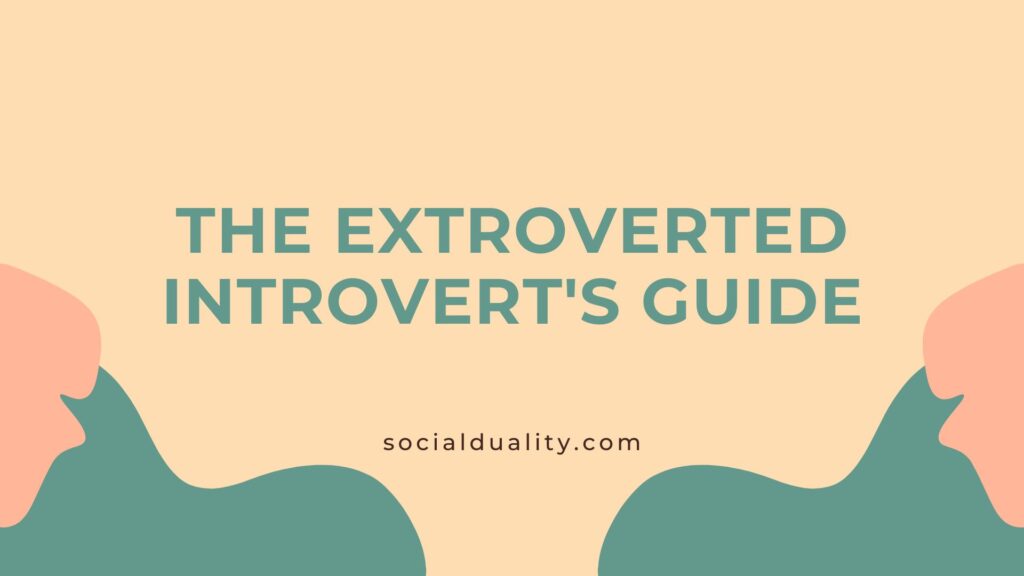Welcome to the intriguing universe of extroverted introverts, a term that may sound like an oxymoron. If you find yourself torn between socializing and solitude, this guide is for you. Extroverted introverts, or ambiverts, exhibit traits from both ends of the introversion and extroversion spectrum. They can enjoy a lively social event but need solitude to recharge their batteries. These individuals are masters of balance, capable of small talk, and simultaneously deeply introspective. This is the reality for many of us, with research suggesting the majority of people identify as ambiverts. So, let’s peel back the layers of this personality type and understand extroverted introverts better, their behavior, and how to nurture their traits.
Key Takeaways
- Extroverted introverts, or ambiverts, have traits of both extroversion and introversion, feeling comfortable in groups but needing alone time to recharge.
- They enjoy social interactions, yet have a limit for socializing and often need time alone or with a few close friends to recharge.
- These individuals can easily switch between being the life of the party to being reflective and introspective, with their energy levels closely tied to their environment.
- Ambiverts excel in balancing their introverted and extroverted traits, making them adaptable and successful in business and personal life.
- Nurturing your extroverted introvert traits involves balancing social activities with alone time, stepping outside your comfort zone, finding like-minded groups, and paying attention to your mental well-being.
Defining the Extroverted Introvert Personality
Unpacking the intricacies of an extroverted introvert personality offers an eye-opening experience. Blending traits from both extroversion and introversion, they thrive well in group settings, yet crave solitude to rejuvenate. They’re the life of the party, yet still find comfort in their own company.
As an extroverted introvert, you’d love social interactions, yet too much of it leaves you drained. A blend of charm and introspection sets you apart. You’d be the host at a party, and later retreat into your shell to recharge. Isn’t that intriguing?
The beauty of ambiverts is their ability to balance both traits. They’re adaptable and excel in roles that require both persuasion and attentive listening. Adam Grant’s research outlines this.
Are you an introvert with extroverted tendencies? You’d enjoy social recognition without actively pursuing it. You’d prefer one-on-one conversations over large group discussions.
Remember, balancing both traits is the secret sauce. Schedule social time, and allow yourself alone time to recharge. Venture out of your comfort zone and find a group that shares your interests. Above all, keep an eye on your mental health.
That, dear reader, is the charm of an extroverted introvert personality.


Major Characteristics of Extroverted Introverts
As we unravel the peculiarities of extroverted introverts, it becomes evident how this personality type strikes a balance between socializing and solitude. Extroverted introverts appreciate social interactions, yet, they savor their solitude too. They feel invigorated by the company of others, but not for extended periods. Their social stamina has a limit, and they need quiet time to recharge.
At a gathering, you’d find them gracefully fluttering between clusters of people, engaged in conversation. But don’t be fooled by the social butterfly act; they prefer profound, meaningful conversations over small talk. As the evening progresses, they might withdraw to a quieter corner, their energy level closely mirroring the dynamics of their environment.
This intriguing personality type is more common than you’d expect. In fact, many people find that they resonate with qualities of both extroverts and introverts. We call these balanced individuals ambiverts.
If you’re an extroverted introvert, you’ll relate to these signs: you feel lonely when alone for too long, yet social interactions drain you. You are a good listener but can engage in conversation when necessary. You enjoy recognition, but don’t seek it, and you prefer one-on-one talks over group chatter. It’s not easy being a social introvert, but with a little effort, you can learn to balance your introverted and extroverted traits.
Do you see yourself in these descriptions? If you do, congrats! You’re one of the many people who fall into the grey area between extroverts and introverts. It’s a fascinating place to be, full of paradoxes and surprises. Embrace the complexity, it’s part of your charm!
Remember, it’s okay to be an introvert in an extroverted situation, and vice versa. You’ve got the best of both worlds. If you’re curious about how the brain of an introvert and extrovert works, I wrote a piece on it. You might find it enlightening. And if you want to learn more about the spectrum of introversion and extroversion, this TED talk does a great job of explaining it.
Table
| Extroverted Introvert Traits | Explanation |
|---|---|
| Social Preferences | Enjoy social interactions, but need alone time to recharge |
| Behavior | Good at small talk, but prefer meaningful conversations |
| Signs | Feel lonely when alone for too long, enjoy recognition but don’t seek it |
| Balancing Traits | Maintain a balance between social time and alone time |
| Differences from Ambiverts | Ambiverts balance extroverted and introverted traits better |
The Social Preferences of Extroverted Introverts
Let’s turn our attention to the social habits of those who exhibit extroverted introvert traits. They often revel in the excitement of a lively crowd, but only for a time. Too much socializing can leave them feeling drained, and they retreat to solitude to recharge their batteries. They’re the ones who find a strange fascination in others, yet get tired of them quickly. Don’t be surprised if they suddenly disappear in the middle of a party. They’ve likely found a quiet corner to gather their thoughts and regain their energy. This behavior of extroverted introverts is just one of the many fascinating aspects of their personality type. They brilliantly balance the best of both worlds, showing incredible adaptability. Yet, they always make sure to carve out time for themselves, a clear sign of an introvert with extroverted tendencies.
Analyzing the Behavior of Extroverted Introverts
If you’re an introvert with extroverted tendencies, you’re not alone. Many people share your extroverted introvert traits. It’s like being a social butterfly with a love for quiet time. You’re the life of the party, yet the solitude of an empty room makes you feel at ease. You’re excellent at socializing, but you’re quick to retreat to your comfort zone to recharge. This delicate dance between extraversion and introversion is what makes your personality type so intriguing. You’re an outgoing introvert, a master of both worlds. You can express yourself in a crowd, but you value your alone time. When it comes to understanding extroverted introverts, we’ve got you covered on our blog. Find out more about these personality types here.
Ambivert and Extroverted Introvert: Spot the Difference
Drawing a distinction between an ambivert and an extroverted introvert can get fuzzy. It’s common for these personality types to overlap, but there are some clear differences. Let’s dig into this. An ambivert can easily slide between large gatherings and quiet solitude. They can chit-chat with ease and then switch to deeper conversations. This flexibility often gives them an edge in business, as they know when to push and when to listen. On the flip side, an extroverted introvert enjoys the company of others but has a limit. They need their alone time to recharge. They might be the life of the party one moment, but the next, they’re craving the calmness of solitude. This dance between being social and needing quiet time is a telltale sign of an extroverted introvert.


Exploring Ambivert Qualities
Let’s take a deeper look at ambivert traits. They possess a special ability to blend into different social settings. This makes them great listeners, adept communicators, and often successful in business. According to Adam Grant’s research, ambiverts outperform their counterparts as they know when to push and when to pull back. Read more about this study here.
Now let’s consider five actions to nurture these traits:
- Schedule social outings regularly.
- Prioritize alone time.
- Step out of your comfort zone gradually.
- Join groups that share your interests.
- Monitor your mental health regularly.
Remember, balance is the secret to managing introverted and extroverted traits.
Signs that You’re an Extroverted Introvert
If you find yourself caught between being social and needing solitude, you might be showing signs of an extroverted introvert. Here’s how to recognize these traits within yourself. Extroverted introverts enjoy being in a crowd but can find it exhausting, needing alone time to recharge. You might spend most of your time listening during a conversation, but when necessary, you can hold your own. Do you require a few moments to warm up in social settings? That’s another indicator. You might appreciate acknowledgement but won’t go out of your way to seek it. Preferring one-on-one chats over large group discussions is another common trait. If these characteristics ring true for you, you’re likely balancing introverted and extroverted traits effectively.


5 Signs of an Introvert with Extroverted Tendencies
As we navigate through the vast spectrum of personality types, it’s fascinating to uncover the subtle nuances that make us who we are. Let’s focus on individuals who embody a mix of introverted and extroverted traits, often termed as “extroverted introverts.” If you’re curious about whether you might fit into this category, consider these tell-tale signs:
- You crave solitude after socializing with a group.
- People fascinate you, yet drain your energy over time.
- You enjoy being the center of attention, but not all the time.
- You’re a good listener, yet can hold your own in a conversation.
- You prefer intimate conversations instead of large group interactions.
If these attributes resonate with you, chances are you’re an extroverted introvert. It’s a balancing act of sorts – relishing social interactions, yet valuing your alone time. By understanding extroverted introverts, you can better navigate your social preferences and maintain your energy levels. If you’re interested in exploring this further, especially in a work context, have a look at our in-depth article on introvert-extrovert dynamics at work. It’s a fascinating read and you’ll surely find it valuable!
Remember, there’s no right or wrong personality type – it’s about knowing yourself and living authentically. So, whether you’re an extroverted introvert, an introvert with extroverted tendencies, or somewhere else on the spectrum, enjoy the ride!
The Frequency of Extroverted Introvert Personality Type
When we take a closer look at the ratio of extroverted introverts, it’s discovered that this personality type is not as rare as one might think. Research suggests that a majority of people, about two-thirds, do not identify exclusively as extroverts or introverts. This means that over half of the population are ambiverts, exhibiting a mix of extroverted and introverted qualities.
| Traits | Extroverted Introverts | Introverted Extroverts |
|---|---|---|
| Social Preferences | Enjoy social time but need recharge periods | Seek out social interactions but value downtime |
| Behavior | Comfortable in large groups; reflective and introspective | Adaptable; balance talking and listening |
| Balancing Traits | Regular social time; enough alone time; positive mindset | Small steps outside comfort zone; join interest groups |
I’ve shared some of my thoughts on communication styles of introverts and extroverts, which you might find intriguing. For a deeper look into this fascinating topic, you might find this article beneficial.
How to Balance Introverted and Extroverted Traits
Balancing your extroverted introvert traits can often feel like a tightrope walk. On one side, you enjoy social events and conversations. On the other, you need solitude to recharge your batteries. So, the trick is to find the right balance. Make sure you schedule regular social outings with friends. This keeps your extroverted side happy. But remember, it’s just as critical to block out some alone time in your calendar for some much-needed recharge. Take baby steps when trying something new. This helps in gradually stretching your comfort zone. Joining clubs or groups that share your interests can provide controlled social interactions. Above all, keep an eye on your mental health and maintain a positive mindset.
| Trait | Introverted Tendencies | Extroverted Tendencies |
|---|---|---|
| Social Preferences | Recharging alone | Enjoying group gatherings |
| Behavior | Reflective and introspective | Comfortable in large groups |
| Ambivert vs. Extroverted Introvert | Balanced traits | Tilted more toward extroversion |
| Introvert with Extroverted Tendencies | Needs time to warm up in social situations | Enjoys recognition |
| Balancing Traits | Regularly schedules alone time | Consistently plans social outings |
Strategies for Nurturing Your Extroverted Introvert Traits
Cultivating your extroverted introvert traits can feel like walking a tightrope. You love to socialize but need your space, so finding balance is critical. Here are some tips to help you thrive as an extroverted introvert:
- Set regular friend dates. Extroverted introverts enjoy socializing, so don’t neglect this need.
- Respect your recharge time. Alone time is not optional, it’s a necessity.
- Push your boundaries. Being an outgoing introvert means you can handle more social interaction than others.
- Join communities that align with your interests. It can be a game-changer.
- Prioritize mental health. Your well-being is paramount.
Remember, every personality type, including the social introvert, has its own strengths and weaknesses. Enjoy the ride!
Conclusion
In essence, being an extroverted introvert is like walking a tightrope. You balance your need for social interaction with your need for solitude. Remember, it’s not about fitting into a box – it’s about knowing yourself and honoring your needs. If you see yourself in these characteristics, you might just be an extroverted introvert.
It’s okay to have days where you want to be the life of the party and days where you prefer your own company. So, go out there and mingle when you feel up to it, but don’t be afraid to take some “me time” when you need it. After all, it’s your personality, and you make the rules.
Being an extroverted introvert isn’t a challenge to overcome, but a strength to be nurtured. Whether you’re networking at a big event or enjoying a book at home, remember to appreciate the qualities that make you, you. It’s a wonderful balance of both worlds.
What is an Extroverted Introvert?
An extroverted introvert, sometimes called an ambivert, shows characteristics of both extroversion and introversion. They can easily fit into large groups, but they need time alone to recharge. These people have a mix of traits from both personality types.
How do Extroverted Introverts behave socially?
Extroverted introverts find social interactions interesting but can feel drained after a lot of socializing. They are often the life of the party or the social butterfly, but they need time to warm up in social situations. They may retreat and recharge alone or with a handful of close friends after a big social event.
What’s the difference between an Ambivert and an Extroverted Introvert?
An ambivert is someone who balances introversion and extroversion well. They can engage in both small talk and deeper conversations, making them adaptable in social situations. On the other hand, an extroverted introvert might need more time to warm up in social settings and may require more alone time to recharge.
What are some signs that someone is an Extroverted Introvert?
If you feel lonely after spending too long alone, prefer listening over talking but can speak up when necessary, take time to feel comfortable in social settings, enjoy recognition but don’t actively seek it, and prefer one-on-one conversations over big group discussions, you might be an extroverted introvert.
How can someone balance their Introverted and Extroverted traits?
Balancing these traits involves scheduling consistent social time with friends, setting aside enough time to recharge alone, stepping out of your comfort zone in small ways, finding groups that share your interests, and keeping an eye on your mental health to maintain a positive mindset.


